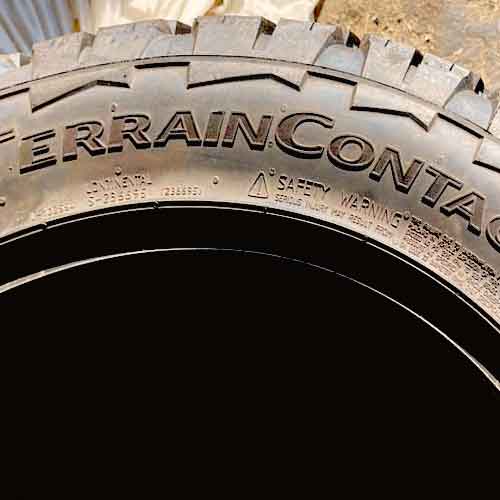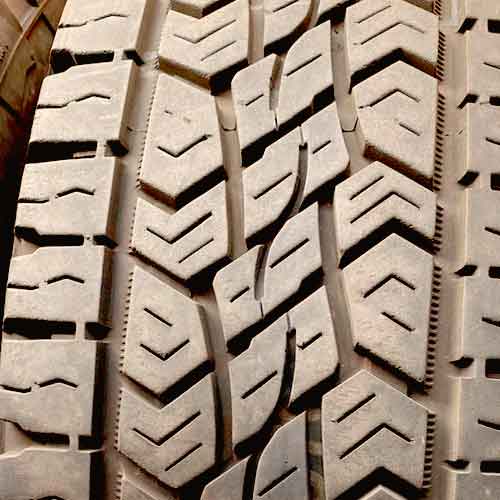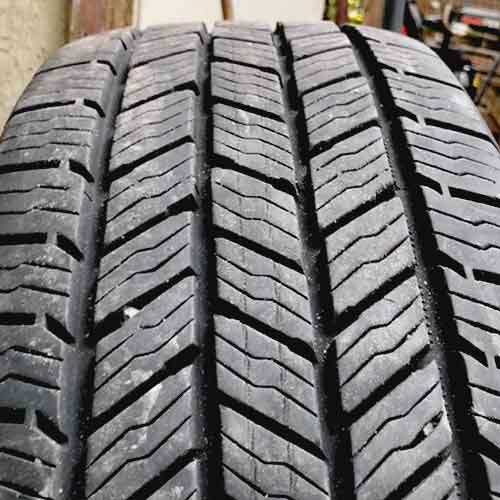Here, the Continental TerrainContact AT comes in All-terrain category, while the HT is a less aggressive highway terrain tire. Both of them although do great on beaten paths, they are still more appreciable when it comes to daily on-road commute. Let’s find a better fit for you out of them.

Being a tire engineer, my testing shows that the Continental TerrainContact HT features a superior grip on dry and wet asphalts. Moreover, it also shows up quieter on pavements, supplies with better fuel economy and gives longer tread life. The TerrainContact AT on the other side, does better off-road, in comparison, and supplies with equally as great winter traction and tread life (considering LT sizes). Moreover, it’s dry grip is only lacking by a margin.
Table of Contents
Tire Sizes:
The Continental TerrainContact AT comes with following specifications.
- Sizes: 16 to 20 inches wheels.
- Speed rating: S, T, H, and V.
- Load ratings: SL to E.
- Weight range: 28 to 66.5 lbs.
- Tread depth range: LT sizes have 16/32″, and P metric have 12/32″.
- Winter ratings: Not available with 3PMSFR.
- Tread warranty: 60k miles.
Detailed review of this tire: https://tiredriver.com/continental-terraincontact-at-review/
On the other hand, the TerrainContact H/T has following.
- Sizes: 16 to 22 inches rims.
- Speed ratings: R, S, T and H.
- Load ratings: SL, XL and E.
- Weight range: 28 to 58 lbs.
- Tread depth range: 12 to 14/32″.
- Winter ratings: Only M+S.
- Tread warranty: 70k for P metric, and 60k for LT.
Tread Design
The Continental TerrainContact A/T offers straight forward longitudinally arranged ribs. It consists of 5 ribs of a very closed up pattern.

The shoulder lugs make a very squared off structure, with deep full depth interlocking sipes on them.
All of these lugs are joined together with connectors/ridges in between, to enhance lateral traction.
In middle there are 3 ribs, where the central most has a wave like structure, and it consists of wider blocks, which basically aid in directional traction.
They have curved notches, rectilinear sipes and foundational supports of secondary rubber layers, where they sit on.
The surrounding ribs although have similar siping pattern, they additionally also features sharp teeth facing the shoulders (which are actually called snow vices).
All these lugs also have secondary rubber layers underneath which connect with shoulder lugs as well.
The Continental H/T on the other hand, comes with a more on-road oriented structure.

In the middle, it forms 3 ribs, making 4 longitudinal grooves.
Like it’s bigger brother, the central two of those voids are narrower compared the outer ones. Though all blocks are of similar geometry.
They carry sharp edges, and full depth interlocking sipes. Moreover, their lateral grooves also have off-set edges in them, forming in-groove biters.
Furthermore, the surrounding ribs have one extra feature; like the TerrainContact A/T, they carry snow vices (saw-tooth biters facing the shoulders).
Moving towards shoulders, the blocks are very packed up here as well. And even the lateral voids they make have connector in between, just like its counterpart.
Other than that, they carry similar siping and don’t have any staggered outer edges, nor give out sidewall lugs.
Directional Grip
This type of grip is judged when a tire is rolling straight. That’s why its calculated with braking distances. And out of both tires, the TerrainContact H/T shows smaller, better values, in comparison.
It’s 3 longitudinally aligned ribs in the middle, are more streamlined towards moving directionally. And lugs in them make minimal tread voids, allowing for maximum connectivity of its contact patch.
Furthermore, these blocks also have chamfered edges, which upon braking don’t push on to each other, allowing for better weight distribution.
In comparison the lacking Continental TerrainContact A/T comes with wider tread voids, and blocks have rubber eaten away by in-groove notches, which could have been in contact with the surface.
Lateral Grip
This grip is calculated by lateral g forces on corners. And since during turns, the weight on the tire gets shifted towards edges, it highly depends on shoulder lugs and sidewalls.
And here again, the Continental H/T is taking the lead with it’s greater contact patch availability and stiffer sidewalls having dual spieally wound cap plies in its internal construction.
The TerrainContact A/T on the other hand, has lugs, more susceptible to flexing, as the tire corners. This compromises on the under and over steering balance, resulting in slowed steering response.
Wet Traction
Wet performance is split into two characteristics: grip and hydroplaning resistance. And they both simply put clear water out of the tread.
Hydroplaning
The hydroplaning occurs when a layer of water comes between the tread and the surface, and its avoided by grooves, which provide pathways for water to leave out as quickly as possible.
That’s why with both tires offering good enough “aqua” channels, supply decent resistance values to hydroplaning (measured with float speeds).
Wet Grip
In terms of wet grip, the overall performance is seen better on TerrainContact H/T, as the tire offers a larger number of sipes all over the tread.
These sipes basically suck water particles in their slits (talking about the left-over water which wasn’t removed by the grooves).
In comparison, the TerrainContact A/T not only lacks in providing ample siping, it’s stiffer tread compound also resist its sipes to have the needed flexibility (to squeeze/contract, and create negative pressure for the water particles).
Fuel Consumption
Rolling resistance, is the most influencing factors when it comes to fuel economy, and its gets calculated by the tire’s weight and its ability to stick to the surface.
And considering them, it can be seen why TerrainContact H/T provides more desirable results.
The tire’s lighter structure exerts less pressure on the (tread) blocks, and its shallower tread depth reduces the flexing and bending of the lugs, which wastes energy, that could have been used to roll the tire forward.
The TerrainContact AT on the flip side does the opposite.
Tread Life
Like mentioned in the fuel section above, the Continental A/T comes with higher rolling resistance, as it’s heavier weight pushes it’s lugs harder to rub with the ground.
And although it negatively affects its tread life, it still pretty great when you consider LT sizes.
This is because on LT sizes, the tire comes with greater tread depth of 16/32″ which takes longer to wear down to 2/32″ legal limit.
That’s why both tires offer similar 60k miles warranty on these sizes, whereas on P metric, the TerrainContact H/T does better and offers 10k more miles.
Tread Noise
Bald tires tend to produce more noise due to the larger volume of air passing through their tread. That’s why even though the Continental TerrainContact A/T is the quietest all terrain tire, it still generates more noise compared to it’s little brother, the TerrainContact H/T.
Noise basically gets generated when air particles hit the (tread) lugs. And these mostly come in through the shoulder voids.
That’s why both tires have noise blockers there. If you consider their tread section, (by scrolling up), you’d note that they both have shoulder connectors.
Though still with a more voided central area, the little air that still manages to come in produces greater noise levels on TerrainContact A/T, comparatively.
Read More:
Are A/T tires noisy?
Winter Traction
Both of these tires although have all season capabilities, they are still not branded with 3 peak mountain snowflake ratings.
Though they are still not too bad, considering other A/T and all-season tires in the category.
But out of them, the H/T yields better grip on packed up, or on-road snow, whereas the TerrainContact A/T can take on deeper terrains.
The Continental A/T basically comes with interlocking central structure with multiple in groove biters which grip on thicker snow with much more effectiveness.
Whereas the numerous full depth sipes on TerrainContact H/T supplies biting on a micro level.
Off Road Performance
Although I don’t recommend going on rugged paths with these tires, you’d still be better off with an all-terrain tire here compared to highway-terrain, obviously.
Though let me still explain why, by considering the following terrains, you mostly face off-road.
Mud Tracks
Mud needs a lot of room, otherwise it would simply get the tread voids clogged, and cause slippage.
That’s why with a more voided structure, the TerrainContact A/T provides better traction. Its interlocking central ribs supply mud multiple channels to leave out, while the shape edges and in-groove biters break down the mud particles.
In comparison, the circumferential aligned ribs of Continental H/T does not allow mud to leave out through sides, and it gets packed with it pretty quickly, losing all traction.
Rocks And Gravel
On rocks you need grip form all angles, as here you almost exclusively face climbing, and so with a limited grip, a vehicle is more susceptible of overturning.
That’s why with a lot more biters, (having multiple angles) the TerrainContact A/T supplies grip in both longitudinal and lateral directions, delivering better overall climbing abilities.
Moreover, although it does not offer stone ejectors like it’s little brother, it still features cut resistant rubber, which supplies better durability and traction on gravely roads.
Soft Sand
Sand is not a place for newbies, as this terrain requires a lot of driving skills, though some tread features help you with that.
The main thing here is to avoid digging, that’s why you always air down you tires here, this allows for better flotation of the tires.
And that’s the reason why, out of both, the Continental A/T, with its sidewall lugs, supplies better capabilities.
Upon reducing the air pressure, its lugs spread out more, and enhance overall footprint availability with the sand, lowering the density of the tire and rendering better sand grip, as a result.
Take Home Points
Both tires, from different categories produce different set of results.
The TerrainContact H/T features a superior pavement traction, and supplies better on-road comfort, fuel efficiency and tread life.
Whereas the TerrainContact A/T does better off-road on all types of terrains, and supplies amazing tread life considering LT sizes.
Furthermore, it’s all season compound also supplies better winter traction on deeper terrains.
Hi,
Nice write-up. I’m going to be looking for new daily tires for my Jeep Grand Cherokee in the spring 2024. I run dedicated winter tires (in WI), so not concerned with snow/ice performance. I’ve narrowed down my choices to the Continental A/T or H/T. Almost every objective test (dry braking, slalom, g-force, lap times) has these two at the top of their classes and at a near match against each other with maybe the only exception of wet braking (A/T = 125.40ft vs H/T = 122.80ft). The A/T is about $20-30 more per tire, and presumably gets worse gas mileage due to its heavier weight and higher rolling resistance.
I’m leaning toward the H/T, but given the A/T performs nearly as well on roads, what are the real world limitations of the H/T when going “off-road”??? I’m probably going to do 95+% of my driving on paved roads (city/interstate). My “off-road” usage will be the occasional gravel road, wet/muddy field, and possibly a forest or logging road here or there (ie. Federal/State/County Forests and Parks). While I might go back to Moab (Utah), I am NOT going to be doing any serious rock crawling or mud bogging. Given the Jeep gets crappy gas mileage to start with, this is another reason I’m leaning toward the H/T…?
I’ve seen some videos comparing an entire family of General tires (HT, AT, ATX, etc.), but not many other brands… General thoughts/suggestions/links?
Thanks.
The A/T tires would give you an edge on more varied terrains, offering better traction on loose surfaces like gravel or in muddy conditions. However, since these scenarios are not the norm for your driving habits, the additional cost and decreased fuel economy may not present a justified trade-off. So I think you should go with H/T instead.
I thoroughly enjoyed reading this article. The information was easy to understand and you were very thorough. Will be placing my order for the H/T tomorrow knowing I am making the right choice. Thank you.
Great articles and website! I have a built wrangler and have done a fair bit of off-roading, including New England rock crawling in pretty tough conditions, for which I’ve always bought tough tires. But I’ve been thinking that, since the jeep still spends 95% of its time on road, maybe I should get some highway-friendlier tires, like the TerrainContact A/Ts and just use the winch more when I’m on the trail. But how would those tires perform aired down so say 15psi? Are they strong enough or is that asking for trouble? BTW, if I don’t go more road-oriented, I’m leaning toward the Mickey Thompson Baja Boss A/Ts. Any advice?
Hey. So looks like you found the very ends of A/T tires in terms of aggressiveness. I mean, Continental TerrainContact A/T is quieter and decent on-road but might fall short off-road, especially aired down to 15psi.
So yes, for rugged use, Mickey Thompson Baja Boss A/Ts are highly recommended, especially for aired down performance.
P.S, take a peek at my air pressure guide for A/T tires, it could be a game-changer for you.
Happy trails!